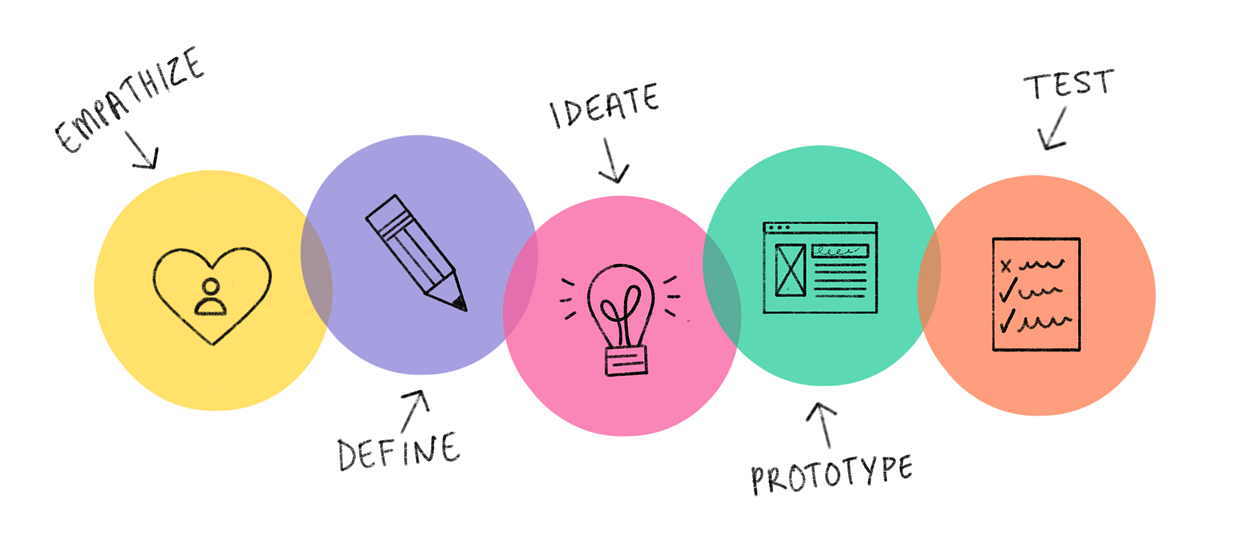Preliminaries of Design Thinking
Design thinking as a tool to getting in touch with customers and users, to understand those segments we are touching through our products and services. Look at our innovations and productions, and what our customer needsPhases in Design Thinking - IDEO
 |
| Source: Design Thinking |
- Inspiration
- Ideation
- Implementation
- IDEO made Design Thinking popular as they were involved in industrial design and product design, and they applied it to different areas
- Involves the intersection of the 3 areas that result in an innovative experience:
- Business (Viability)
- People (Desirability)
- Technology (Feasibility)
 |
| Source: Design Thinking – Human Centred Design |
- Business + People = Emotional innovation (brands, marketing, relationships)
- People + Technology
The IDEO process was further developed by Stanford University.
- Empathize - this involves experience the problem from the user/customers perspective by understanding their needs and desires.
- Our goal is to get a clear idea of users/customers by unpacking the problem from the customers view point.
- This can be done through stories, ethnographic research
- We go deeper to understand the reason why users use a product/functionality in a specific way through observation
- Define - this deeper understanding of the user will enable us to analyse and synthesise the solution by defining the needs, using insights from observations and form patterns that will assist in clarifying the problem
- Guiding criteria can assist in setting the boundaries of the project and its true purpose
- A conceptual feeling is generated to analyse the user for instance through:
- Personas - a fictional character used for the observed behaviour among the consumers with extreme profiles. This draws out the characteristics of the user, in essence by putting a "face to the customer".
- Empathy maps - this is a visualization of the clients thoughts and feelings. This tries to draws out what the client sees or hears about the product that may influence their behaviour
- User's Journey - this is how the user engages with the product or service such s the steps taken before and after purchase
- Blue Print - this is a visual representation of things the customer would like for us to improve upon
- Ideate - this is now trying to brainstorm and create solutions by sharing ideas, asking the community. The can team building and prioritizing the solutions. A decision matix will then eb validated as being part of the guiding criteria and needs of persona
- Brainstorming - the purpose is to try to generate a large number of ideas regardless of impossible or unreasonable an idea could be. This works as a method to stimulate a conversation
- Co-creation - this tries to stimulate creative juices and collaboration as a method to drive innovation. This may be cross-functional teams, stakeholders adn even a persona
- Menu of ideas - A focus group that engaged possible opportunities and ideas that are organized and grouped together
- Prototype - this is looking at a minimum viable product that helps us try to get an idea about the final product. This is really about helping us represent the ideas to the client to understand if it meets the client needs with the goal of refining the idea and testing it with the user.
- Stating scenario
- Story board
- Test - this involves the solutions together with the user and is an opportunity to gain deeper empathy to understand what works
Thoughts on Design Thinking
This was a very interesting session, and engaging. I've come to understand that the innovation funnel starts wide and goes narrow by starting with big ideas and heading towards a solution.
Design thinking a mindset, process and methods focuses on human values. The goal of design thinking is to show do not tell the client about the product. There is also embracing of experimentation. Within design thinking we are mindful of the the process. This is a collaborative approach that leads to action. This is also crafts clarity in the design process and is a useful tool in collaboration.
I've also come to understand that design thinking can be used in conjunction with normal software development life cycle (SDLC) methods, and is really at the start of the process. It is really about the requirements gathering and will usually be included when embarking on the project. It can also be used as a tool to determine relevance of the product to understand if a product can be improved even before a project is started, but this does not mean that it can be lead to new projects based on the outcome of the process. Design thinking does not necessarily have to be a lengthy process but can be used quite quickly to enrich the information that will lead to an improvement or a solution.
Skills Learnt - Empathy Map
As part of the course I had to develop an Empathy map. This Empathy map is for each customer segment and helps us understanding the customers views and perceptions of our products. It is a great tool for understanding customer experiences.

